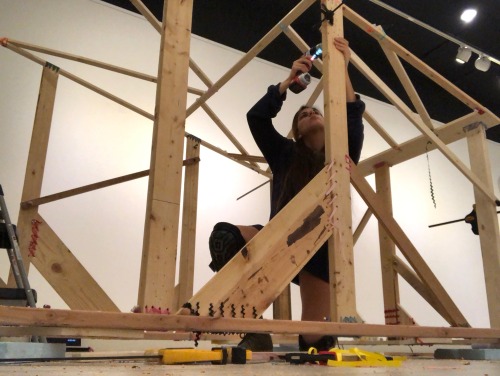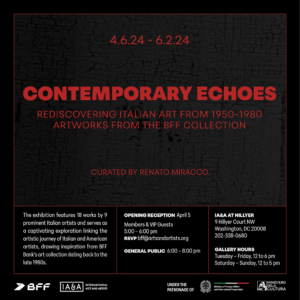
Nine Patch: Q&A with Olivia Tripp Morrow
Olivia Tripp Morrow received her BFA in sculpture at Syracuse University, graduating cum laude in December of 2012. Her most recent works are video and sculptural installations that address concepts relating to beauty, intimacy, memory, sexuality, and the commodification of women’s bodies. Morrow’s work primarily utilizes found and donated textiles as material, which are imbued with social and cultural values as well as personal histories. Through her work, Morrow draws connections between status quo notions of beauty/luxury and the perpetuation of harmful social norms and expectations placed on women and girls. Morrow’s work has been exhibited nationally and internationally, and she has permanent installations and works on-loan at the National Institute of Health’s Clinical Center in Bethesda, MD, the Anacostia Arts Center in Washington, DC, and the Arlington Art Center in Arlington, VA, where she is a current Resident Artist.
Your work addresses the human body and the experiences of human bodies through abstract installations. Can you tell us a bit about how you arrived at this theme?
The core of my work and studio practice comes from a personal context. I was twelve when I discovered that my body was perceived by my peers as a mishmash of individual physical parts entirely separate from each other, and which could be rated according to a numerical scale. In high school I learned that my value as a person could be defined entirely by my physical appearance. As an adolescent, my appeal for perfectionism mutated into a crippling fear of making mistakes or being perceived by others as inadequate—physically or otherwise. (This was before smart phones or Instagram, so I would imagine it’s only getting harder for young girls today.) Grappling with notions of beauty, bodies, and intimacy, as well as social structures that attempt to exclude and invalidate people who don’t fit neatly into conventional measures of beauty, have been important to why I create work and what I want it to do.
It’s practically impossible to filter out the incessant bombardment of media and advertisements that reinforce harmful and equally narrow definitions of beauty, bodies, and gender-appropriate behaviors, all of which normalize obsessive fixations on so-called imperfections and breed exclusivity. Once I realized what I was looking at I saw it everywhere: relentless reminders to buy whatever product or thing that would seem to simultaneously present and offer solutions to the apparently boundless inadequacies of my appearance. This subliminal conditioning can be highly effective, but knowing what strings these industries are trying to pull at can at least give us a chance to resist them.
What is the purpose of using donated materials in your work?
For the past few years my work has been driven by donated women’s clothing, undergarments, bedsheets, and other used textiles that I began collecting in 2015. Along with these donated items, many women shared personal stories associated with them: Fond memories of family, travel, and past lovers were contrasted with darker recollections such as an outfit that someone was wearing when they were assaulted. Like much of my favorite work by Sonia Gomes, Shinique Smith, and Senga Nengudi, whose found and donated materials seemed dense with meaning upon arrival, the donated textiles I received were imbued with personal history, familial tradition, social narrative, and political context.
In the context of the current exhibition at Hillyer, Crochet II is a single-channel looped video that utilizes a blanket that was crocheted by my great-grandmother. The significance of the blanket itself lies in its personal and familial sentimentality, and implications of domesticity. The intricate, open floral patterning of the blanket and mesmerizing shapes that at times resemble female genitalia might give the initial impression that it is delicate and decorative. However, its actual strength and durability defy these assumptions once it’s discovered that a person is moving around underneath, pulling and stretching the fabric to its limit. Similarly, the five printed photo quilts in Nine Patch are comprised of thousands of selfies taken while underneath used crocheted blankets, and simultaneously conceal and reveal my body.
While I grew up using crocheted blankets and handmade quilts as functional objects that were made by family members and passed down over generations, I never saw them being made by those family members. By the time I was born, the generation that labored over these textiles had passed, and their tradition and skill set largely disappeared with them. It was only as an adult that I began to consider the labor that went into their creation, and all the implications of that labor in the context of times and places that I never lived in.
Do you plan out your ideas meticulously before making an installation, or are you more improvisational? Can you take us through your creative process?
My materials and their physical properties guide my formal decisions while creating new work. I spend a lot of time experimenting with and discovering the limits of materials, such as how much something will stretch or bend, the weight something can hold, the shapes it can take, the way it might transform in different spaces. Even when I have a clear idea about some new piece or body of work, I rely on my intuition and remain willing to abandon parts of the work in exchange for a potential discovery that I might not find otherwise. Executing procedural steps has never been very exciting to me, so it’s often the curiosity about “what would happen if...” that leads me forward in my studio. There’s freedom in this process; permission for boldness, taking risks, and failure from which better ideas are (sometimes) born.

You entered art school to study painting and illustration. What drove you to make a shift into abstract installations?
Having started my early work as a painter, I am influenced by formal techniques of painting: color used to create receding or expanding space, light that reveals/conceals, and the varied expressions of human emotion. But as a freshman in college I found working exclusively with paint and 2D surfaces limiting. I wanted to get lost in experimentation with new materials and processes, so I transferred to the Sculpture department. I am also captivated by the potential for artwork to completely transform my relationship to objects and physical space. Exploring scale and spatial relationships and considering the ways we navigate spaces translates well into this medium. In my third year as an undergraduate student, I realized that it was possible to essentially make “paintings” that people could walk under, around, or through, and which could be experienced differently from a multitude of perspectives. Installation has dominated my practice ever since.
What concepts are you currently exploring in your studio, and what kind of work can we expect to see from you in the future?
Lately I’ve been working really hard to push past certain comfort zones in my studio practice. The photo quilts in Nine Patch and the work I made for a simultaneous two-person show (called Within/Between, with artist Jen Noone at the Arlington Art Center) were an important departure from that comfort zone. While making work for Within/Between, one of the things that both Jen and I were reflecting on in our own way was materiality and function. One of my pieces (Ribbon House, 2018) is a large, shelter-like structure that is robust and meticulously constructed using scrap and found wood. Instead of hardware or glue, the structure is held together with materials normally considered decorative or inane: ribbons and beads.
It was a huge challenge to put these two exhibitions together within a week of each other, but the works in each were influenced by each other, so it feels really good to have them open simultaneously. Right now, I am in the middle of changing studios, but I’m excited to start a new residency at the Arlington Art Center and to get back to work.

